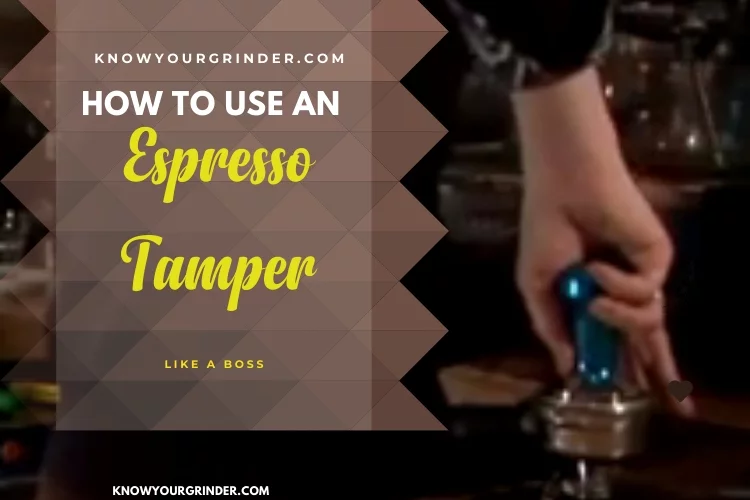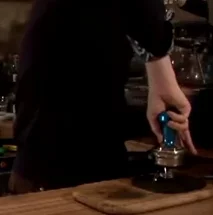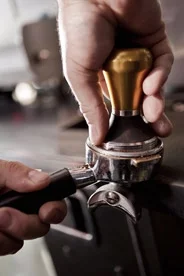How To Use An Espresso Tamper Like A Boss
by Selmir Omic
For even the biggest espresso fan, there's always something new to learn. There are so many blends, brewing methods, etc. that it could take a lifetime to master them all. A fine example of this is tamping.
To the beginner, an espresso tamper may be one of the slightly less well-known coffee accessories, however, you've probably seen them around cafes as they are necessary to pull top-notch espresso shots.
Contents
(If you already know the basics of tamping, and just want the hot tips, click here)
(Shopping for a good tamper? Click here!)
To those in the business of making espresso, having the best espresso tamper for your personal needs is to a barista as a quill pen might have been to Shakespeare, or a bowl of quaker oats might be to Wilford Brimley, meaning they are practically inseparable.

To the beginner home espresso brewer, an espresso tamper is a piece of equipment you're going to want to get to know, and learning how to use a tamper will guide you through your darkest hour of making batch after batch of foul brew only to finally end up with the perfect cup of black gold!
What Is An Espresso Tamper & What Is It Used For?
For those not too familiar one with one of these little beauties, an espresso tamper is usually made of materials such as metal, wood, plastic, or rubber. In fact, they can be made from combination of any of those materials, but a metal like steel or aluminum is strongly preferred. You can also attach some crazy-looking puppet to it, for style (like the one on our left here). Really, the small variations between tampers means no two tampers are quite alike!
And what does this small, hand-held device do exactly, one might ask? You guessed it, it tamps! But what is "tamping", and how does it benefit the preparation of coffee? We like to think of it as an onomatopoeic word, meaning it sounds like the action that it carries out. At least, that's our opinion. Tamp, tamp, tamp…
What Is Tamping?

Essentially, an espresso tamper helps us to pack our ground espresso into our porta-filter, so that we can extract water though it and so we can end up with a delicious espresso. If the coffee in the porta-filter is loose, or un-tamped, when the hot water hits it, the extraction process would not work properly and you'd be left with some very weird, watery espresso.
What we want with our espresso extraction is a nice, even, slow extraction and having the best espresso tamper that suits your needs is key in order to get this. You also don't want to do the job unevenly, as it will result in "channeling", where the water can pass through one side quicker than the other, and we don't want that either. This is why we must pay close attention to the finer details of our new tamper when purchasing, so as we can get the highest quality tamp possible for the money we spend on our espresso tamper.
Here's a quick video to show how to use an espresso tamper from the fine folks over at L.J. Coffee House in Soho, London ( click here to visit them on Facebook), before we jump into more detail on the process.
Benefits of Tamping
To reiterate, the key benefit of tamping is that the particles of ground espresso form a greater resistance to the water that will be filtered through them. Of course, tamping itself is just a quick process of a few seconds to pack down the coffee into the porta-filter, but it is a key few seconds indeed!
Because it's more difficult to water to pass through the ground coffee or espresso (because typically we're talking espresso here), the slower the extraction of the flavor from the beans. As always, good things come to those who wait. More espresso flavor and aromas are then extracted as time passes, with the end result being that the espresso will have more flavor, which is definitely the goal.
What Is the Best Espresso Tamper For Your Needs?
It's important to realize that choosing an espresso tamper is somewhat like choosing a pair of shoes or a car. Even if a particular one is very popular, it doesn't necessarily mean that it's a good choice for you. It's important to "test drive" various tampers in order to find the right one for you. Make sure to hold it to test if the weight and contour are good matches for your hand.
Besides checking how well the tamper works in terms of your hand, you should also test it in relation to the porta-filter. The size of porta-filters range from about 45 mm to 60 mm.
What's most important when selecting the best espresso tamper in terms of matching up with the porta-filter is that it will fit snugly in the basket, but won't stick to the sides. It's better for it to be a little smaller than the basket's circumference, rather than too large.
Like A Boss
As with other types of coffee brewing processes, it's critical to use the right steps and techniques when tamping espresso. We've already touched on a few of the things you'll want to keep in mind when purchasing a tamper, but now lets get into the nitty gritty of the real technique you should use. Here are some basic steps in order to maximize the effectiveness of tamping:
Making The "Puck"
The "puck", as it is so named, is the ground espresso which has been compacted into our porta-filter by our tamper prior to the coffee extraction process. Here are some steps to make the perfect puck:
Before you start making the puck, make sure that all of the components of the espresso machine are functioning properly and as clean as possible. This will help to ensure that the coffee you prepare is the best it can be. When cleaning the tamper, it's critical that you don't use a dishwasher. Instead, the only materials you'll need are a cloth, soap, and warm water. Once you've given everything the green light, you're ready to tamp!
A Quick Video About Making Espresso The Correct Way
Arm And Hand Form While Tamping
It's important that your wrist be straight while tamping the ground espresso. This provides the most control during the process. Point your elbow upwards so your forearm and bicep form a 90° angle. Then hold the tamper handle as if you were holding a door knob. This will create two forms of contact, while will help to keep the tamper as stable as possible during the tamping process.
Use your fingers to check the tamper's stability. Keep holding the tamper handle as if you were grasping a doorknob. Then use your fingertips to check the height difference between the tamper base's top edge, and the filter basket. Check that the height is balanced on every side.
Use Just Enough Pressure
When packing the grounds, it's important to use the right about of pressure, and avoid using too much pressure. Its a delicate balance! Using too much force could not only affect the quality of your coffee, but also your health. In particular, you could experience Repetitive Stress Injury (RSI).
Much ado has been made in the past about the amount of pressure baristas need to use when tamping. However, espresso experts have discovered that there are several factors involved, such as the type of grind and quantity. It's better to tamp lightly to ensure that the coffee grounds are level in the filter. The next step is to lift the tamper and then firmly apply it again-but not overly so. Of course, its going to take some practice in order to become a "boss", as we mentioned. Consistency is the real key here!
Verify that the tamper is level atop the grounds

Take this step while holding onto the filter. This is a critical step because if the grounds are uneven then they'll be packed more in one region than another. This will result in an extraction that's uneven and variable. Uneven tamping will prevent you from enjoying the best cup of espresso possible, a tragedy we wish to avoid.
The "polish" or twist - getting it right
Tamper and "polish" with two different motions. Some baristas "polish" (twist) the coffee grounds, meaning that they kind of turn the tamper in order to further flatten the grinds. There's much debate about whether or not this is a necessary step. What's important to keep in mind is that the two actions (tamping vs. polishing) have two different functions. Tamping keeps the coffee grounds packed in the filter. Meanwhile, polishing/twisting helps to keep them evenly distributed. Try it out for yourself and determine whether you feel the polish is a necessary step in your espresso making process.
Keep the pressure consistent
Ah, the pressure, the PRESSURE!
While you should ideally use 40-45 pounds of pressure while tamping your espresso, one could make the argument that it's difficult to gauge how much pressure that is. We are not machines here.
Some coffee experts even argue that the amount of pressure isn't as important as keeping the tamping pressure consistent, as the water hitting the grinds will inevitably loosen the tightly packed puck we have created. In that sense, no matter how much you pack the ground espresso in there, the water is going to come along and loosen it up.
This debate about the proper amount of pressure while tamping espresso will probably never end about which method is right. While you certainly could add too little or too much pressure if it's too one extreme or another, it could yield less than ideal results. What's important is that you use consistency when adding whatever pressure you do apply. There's no avoiding it - you're going to have to play around a little bit to figure out what works for you. We think of it like playing a musical instrument. You want it to sound good, but you're still going to play it. Its got to be enjoyable, and somewhat flexible.
All the same, you'll want to keep grounds away from the top of the filter basket (porta-filter). It's important to keep this area clean while tamping your coffee. This will help to protect the filter and reduce maintenance on your espresso machine.
Pictured left is a porta-filter with espresso grinds which has yet to be tamped. Were this tamped already, this is almost too close for comfort. Once tamped, it will be at the perfect level to insert in our espresso machine and begin the extraction process.
Store the gasket properly and replace it when necessary
The gasket is one of the most important components of an espresso machine. It's critical that it provides us with a watertight seal. Over time, they will wear out, as they aren't made to last forever. Once they do, if the gasket isn't changed soon a perilous situation could arise, and water will in fact leak out of the grouphead, and then around the group handle.
One of the best ways to extend the life of the gasket is ironically to use it less. If there are months that you won't be using the espresso machine, then take some time to store the gasket properly. Remove it from the espresso machine, and then lubricate it with either vaseline or olive oil. You can place the gasket in an airtight plastic bag. This will help to prevent it from drying out. Just be good to your gaskets!
SySrion Espresso Tamper
As when buying other espresso-making items, it's important to set a budget before you start shopping around. That will help to ensure that you buy a tamper that you can realistically afford.
For instance, the espresso tamper on our left, made by our friends at SySrion, is basically a $20 tamper which looks great aesthetically, but don't hurt your wallet so much. This is actually a really good coffee tamper as it is heavy duty, unibody design, with a 58mm base diameter, aluminum grip, and stainless steel construction. For around $20, that's a lot of value. This tamper is also perfect for the Gaggia Classic Espresso Machine.
What determines the price for a decent tamper? Factors include: whether it's branded, the size, the material, whether its flat on the bottom or convex, among other factors. Even small details such as exactly how nice and round the handle is, or whether its solid steel vs. plated steel can make a difference in the price. Its all about the specifics!
Motta Professional Espresso Tamper
The best espresso tampers can often run as high as $50, which might seem like a lot for such a small piece of coffee equipment, but for those who are serious about their espresso, getting the best coffee tamper you can is kind of a big deal. Being a coffee aficionado and having a cheap tamper would be like being an author, and the only having a cheap pencil to write with, instead of a nice laptop or using an old school typewriter (like Stephen King).
For instance, to our right we see the Motta Professional model espresso tamper. Because of the type of wood used in the handle, the shape of the tamper (convex, not flat), and the unique insignia, this particular tamper fetches for around $50, and earns itself the title "professional". However, if you're looking for a real showpiece, one of these tampers certainly looks darn impressive, and it works like a charm.
Rattleware Long Round-Handled Espresso Tamper
On the left here we have the Rattleware Long Round-Handled tamper, one of the best espresso tampers on the market. This is another model that goes for around $50, but you definitely get what you pay for here because everyone rightfully loves this model.
For such a simple looking piece of gear, what is it about this model that makes it a cut above? Well, it has size going for it, at 58mm, which again makes it another great candidate for the Gaggia Classic espresso machine. This might be a good time to raise the point that you want to double check when buying a tamper that it will fit with the porta-filter that goes with the espresso machine you're using. Many a sad soul has purchased a tamper only to discover that it doesn't fit with their porta-filter, which is indeed unfortunate, so look out for that!
Other pluses with this particular tamper is its plastic, non-slip handle, its solid steel body, and its general heavy-duty-ness. You really can't go wrong with a tamper like this one!
Barista Espresso Tamper by Generic
Lets take a look at one more tamper, this time in the less expensive category at just over $10. The tamper to our left is the curiously doorknob-esque, 51mm Barista Espresso Tamper by Generic. For a less expensive tamper, this one is very well reviewed and espresso fans love it. Read more about this inexpensive but great tamper.
The Vktech tamper here is made of plated steel and a has a unibody design. To be sure, this looks like a very upstanding coffee tamper, but when you get out the magnifying glass, there are reasons that it only costs about ten dollars versus the above tampers which run twenty, even fifty dollars.
Still, this is a great little tamper to start out with as it still has a heft to it, with a nice flat bottom, and it also fits in most porta-filters. Nice!
We always feel we should receive a discount on some of these tampers just because we're so darn sassy, but a lot of places don't seem to take our all-sass discount card. 😉
This concludes our article on how to use an espresso tamper like a boss! We feel that if you follow our sagely advice, you too will soon be tamping up a storm and pulling amazing espresso shots in no time. Thanks for reading!
RELATED VIDEOS
 |
 |
 |
 |

About Selmir Omic
Selmir Omic is KYG's cannabis lifestyle writer. He currently resides in San Francisco and can often be found enjoying design-forward cannabis accessories, candles and seltzer simultaneously. When he's not writing about pot or waxing poetic about vape pens, Selmir can be counted on to offer sage advice about the best strains for anxiety or how to make cannabutter without a stovetop.
Thoughts on "How To Use An Espresso Tamper Like A Boss"
 |
 |
 |
 |
Get FREE Coffee Gifts now. Or latest free grinders from our best collections.
Disable Ad block to get all the secrets. Once done, hit any button below
 |
 |
 |
 |